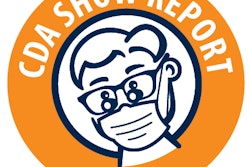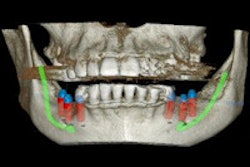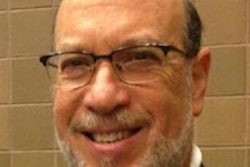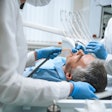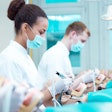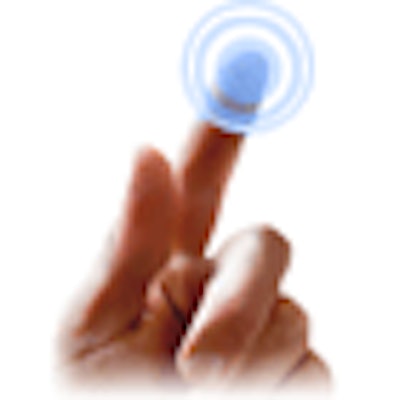
The banner hanging from the ceiling of the Moscone West Convention Center in San Francisco said it all: "The future of dentistry meets here."
Numerous presentations at the recent ADA 2012 Annual Session focused on how to successfully integrate digital technologies into a dental practice, and several key opinion leaders shared their thoughts on specific products and services and why now is an optimum time to consider "going digital."
 "The future of dentistry meets here." was the theme of the ADA 2012 Annual Session in San Francisco.
"The future of dentistry meets here." was the theme of the ADA 2012 Annual Session in San Francisco.
In addition, "hot topic" panel discussions ranged from the recession's long-term impact on dentists' profitability to controversies in implantology, screening for medical conditions in the dental office, and new insights into the causes of osteonecrosis of the jaw (ONJ).
"Everything comes full circle," Marty Jablow, DMD, a private practice dentist in New Jersey who blogs and lectures regularly about dental technologies and is a member of the Pride Institute's Best of Class expert panel (see sidebar). "What was the newest and latest this year at the ADA? For 15 years it was cosmetics, before that it was implants, and before that it was TMJ. Now we are looking at things from a broader spectrum and treating patients for things we never did before. This trend is driven by maximizing the potential in your dental office. But what we can do for our patients is changing too, and we are using technology to drive that. We're starting to look at the entire person, not just their teeth."
Interest in dental technology was quite evident throughout the ADA Annual Session Exhibit Hall this year, noted Lou Shuman, DMD, president of the Pride Institute and creator of the Best of Class Technology Awards. The Pride Technology Expo presentations were sold out and saw standing-room-only crowds throughout the session. The focus on digital radiography, digital impressions, caries detection aids, micromotors, restorative materials, digital denture technology, oral cancer detection, high-tech data backup, light curing, lasers, patient education software, online communication tools, and light systems all caught the attention of the attendees, according to Dr. Shuman.
"What became obvious to us at the meeting was a greater desire to add these technologies into the dental office," he said. "Where some of these technologies will have significant integration throughout the U.S., both due to the impact they can create and their affordability, this year there was much greater buying interest in the more expensive technologies such as Sirona Cerec 4.0, Align Technology's iTero, and Sirona Dental Schick Wifi. These technologies represent the state of the art in the digital realm with enormous advantages to the practitioner. They will not only bring enhanced clinical diagnosis and treatment capabilities to the practitioner, their patients will benefit significantly as well."
“Everything comes full circle.”
There is an assumption that technology takes dentists away from their patients, "but that is not true," said Amy Morgan, CEO of the Pride Institute, in a presentation entitled "Creating a Technology Culture." "Today's technology enables you to be closer with your patients, to 'touch them' in new ways."
Paying attention to new technologies has become increasingly important because business is happening at the speed of thought, she said. "Everything is happening faster. Business is going to change more in the next five years than it has in the last 50."
Computerizing your office from the front desk to the operatory and beyond leads to more effective and efficient dentistry that patients appreciate, according to Claudio Levato, DDS, who participated in a Virtual Design Panel at the ADA meeting. Dr. Levato has been practicing in the Chicago area since 1976 and first began computerizing his office in 1982.
"Technology allows us to filter and organize the flow of information in a dental office," he said. "Technology facilitates same-day procedures. Technology lets you preplan to save chair time. Technology validates quality."
Unfortunately, because many dentists don't know what is possible, "they buy random technology that may or may not be useful in their office," added Larry Emmott, DDS, founder and director of Emmott on Technology and a leading speaker on technology in dentistry, during the Virtual Design Panel.
Where to start?
Hand in hand with the challenge of determining which technologies are right for your practice is ensuring that the entire dental team is on board with the transition. The key is to have a vision and to clearly communicate the benefits and engage the team in the decision-making process, Morgan noted.
For example, when considering a new technology purchase, she recommends asking yourself these questions:
- Will this technology reduce your stress?
- Will it increase efficiency?
- Will it improve morale?
- Will it increase productivity and profitability?
- Will it create more balance?
It is also important to keep in mind how to get your team and your patients to embrace the new technologies and new ways of doing things, Morgan noted.
"When we do our technology assessments with Pride clients, we find that offices are either uncomfortable with technology, find it difficult to integrate the new technologies with their clinical practices, can't afford it, or that their patients are uncomfortable with it," she said.
If you are going to sell your team and your patients on a new piece of equipment and make your technology purchase a success, she emphasized, "you need to be able to answer these questions for them: Why do we need to make this change? What's in it for me (how is it going to make me better at what I do)? And will I be able to learn how to use it?"
Providing appropriate training also is critical, Morgan added, noting that too many practices often overlook this when they change a process or install a new piece of equipment.
Marketing the new technology to your patients is equally important, she noted.
"You need to engage your patients so they want to do what you want them to do," Morgan said. "Having a link to a website explaining the new technology doesn't engage. You don't want to just say, 'We do CAD/CAM restorations.' You need to emphasize efficiency and quality, affordability and effectiveness."
Digital impressioning gets real
|
Pride Institute's Best of Class, 2012-2013 The third annual Pride Institute Technology Expo, held on the exhibit hall floor during the 2012 ADA Annual Session, featured technology-oriented continuing education courses alongside booths showcasing Pride's 2012-2013 Best of Class winners. Here are this year's winners:
|
From a technology perspective, chairside CAD/CAM was one of the hottest topics at this year's ADA meeting, with the introduction of several new or improved products.
In fact, with equipment costs dropping and technology improvements coming at a breakneck pace, digital impressioning is becoming an increasingly attractive and affordable option for general dentists, according to a presentation by Parag Kachalia, DDS, vice chair of preclinical education, technology, and research in the department of integrated reconstructive dental sciences.
Digital impressioning is changing because the marketplace has developed a better understanding of dentistry and is developing products that better address dentists' needs, Dr. Kachalia emphasized. "They're asking questions like, 'How can we take scanning into the office?' And now we're getting to the point where digital dentistry is like an iPhone."
The industry could see another 20 digital impressioning systems enter the marketplace during the next five years, he contended. "Acquisitions have made smaller companies more viable," he said.
Dr. Jablow agreed.
"A lot of companies we haven't even seen yet [in the U.S.] are developing products for release," he said. "Some are available in Europe and are getting ready to make the jump to the U.S. And the price points are going to come down to probably half the price of current technology, in the $60,000 to $75,000 range."
In the meantime, new product introductions abound. In August, Sirona Dental introduced the Cerec AC Omnicam, which features full-color streaming video capture; a smaller, more ergonomic handpiece; and a completely powder-free process. While a complete Cerec AC/Omnicam system -- including the milling unit -- will cost $129,995, the company believes the technology advances offer practitioners a number of advantages, both clinically and for patient education.
3M ESPE is attempting to address the pricing issue with its new True Definition intraoral scanner. Unveiled at the ADA meeting, this scanner "changed my opinion of digital dentistry overnight -- the prices dropped in half," Dr. Kachalia stated. The scanner retails for $11,995, with data plans starting at $199 per month. Other scanners on the market sell for $20,000 to $30,000; however, some analysts have questioned the long-term per-month data charges.
While CAD/CAM manufacturers continue to work out their pricing schemes, the technology continues to improve, making make digital restorations an increasingly attractive option for general dentists.
"Studies show that digital impressions are equally, if not more, accurate than traditional ones," Dr. Kachalia explained. He described a clinical case he participated in involving dental students in which 100 restorations were performed with a 22% decrease in time.
In his opinion, the Trios by 3Shape will become increasingly competitive due to its quality. "It's not prevalent in the U.S. [yet], but lab techs know," Dr. Kachalia said. "And it has a huge presence in Europe and elsewhere abroad."
The E4D by D4D Technologies also received praise. "It's the first in-office, powder-free scanning and milling system and has the ability to design multiple restorations at one time," he said.
Early caries detection
Another technology session at the ADA meeting compared four devices that use light from a laser or light-emitting diode (LED) to enhance the ability to detect caries.
John Flucke, DDS, a general dentist from Lee's Summit, MO, who is the technology editor for Dental Products Report and a well-known dental "technophile" who blogs regularly about dental devices, evaluated two classes of devices: those using probes (KaVo Diagnodent and Midwest Caries I.D.) and those using visuals (Air Techniques Spectra and Acteon Soprolife).
The KaVo Diagnodent uses a 655-nanometer (nm) diode laser to measure caries fluorescence with digital and audible diagnostic indicators for immediate feedback. This helps dentists be more conservative in their treatment decisions. The KaVo Diagnodent boasts an accuracy rate of more than 90% and recommends restorations at readings greater than 30. But Dr. Flucke said he takes other factors into consideration, including the patient's age, history, and habits.
The Midwest Caries I.D. uses LED technology instead of numerical readings and provides immediate feedback via audio beeps. It is designed to detect caries in fissures and on smooth surfaces. The LED light enters the tooth and captures the resulting reflection and refraction of the light in the tooth.
Dr. Flucke said he prefers the visual devices because they allow him to show patients the healthy versus caries areas of their teeth on monitors.
The Acteon Soprolife requires a computer and emits a light of 450 nm for caries detection. It measures caries fluorescence, which shows up as a glow on monitors; violet indicates caries and white indicates healthy teeth. The Soprolife can be used as an intraoral camera and integrates with Dentrix, Eaglesoft, and other imaging modules.
The Air Techniques Spectra is a caries-detecting intraoral imaging system that utilizes six LEDs and an array that emits a 405-nm light to measure bacterial metabolites called porphyrins. When viewed on computer monitors, healthy enamel appears light green and caries appears red. The images look like Doppler weather radar waves, with different colors showing how deep caries are. The images also allow comparison so dentists can monitor caries development over time.
While he believes these products add value to the caries-detection process, Dr. Flucke emphasized that he still uses bitewing x-rays and an explorer.
"I definitely don't use these devices to make decisions for me," he said.




